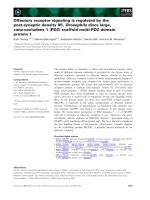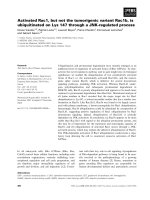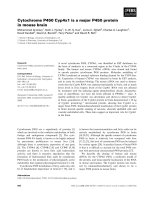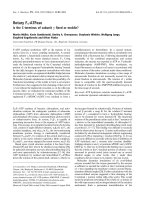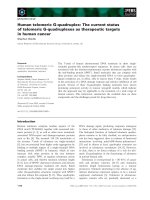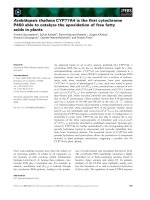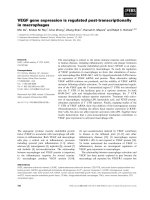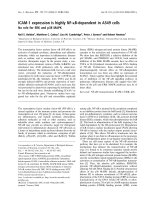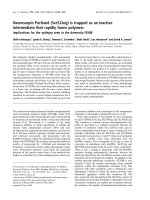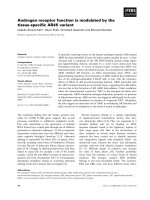Báo cáo khoa học: "Male breast cancer: is the scenario changing" potx
Bạn đang xem bản rút gọn của tài liệu. Xem và tải ngay bản đầy đủ của tài liệu tại đây (404.44 KB, 11 trang )
BioMed Central
Page 1 of 11
(page number not for citation purposes)
World Journal of Surgical Oncology
Open Access
Review
Male breast cancer: is the scenario changing
Kaiyumars B Contractor*
1
, Kanchan Kaur
2
, Gabriel S Rodrigues
3
,
Dhananjay M Kulkarni
4
and Hemant Singhal
1,2
Address:
1
Department of Surgery, Oncology, Reproductive Medicine and Anaesthetics, Imperial College, London, UK,
2
Department of Surgery,
Northwick Park Hospital, London, UK,
3
Academic Department of Breast Surgery, Nottingham University Hospitals, City Hospital Campus,
Nottingham, UK and
4
Department of Surgery, Queen Mary's Hospital, Sidcup, Kent, UK
Email: Kaiyumars B Contractor* - ; Kanchan Kaur - ;
Gabriel S Rodrigues - ; Dhananjay M Kulkarni - ;
Hemant Singhal -
* Corresponding author
Abstract
Background: The overall incidence of male breast cancer is around 1% of all breast cancers and
is on the rise. In this review we aim to present various aspects of male breast cancer with particular
emphasis on incidence, risk factors, patho-physiology, treatment, prognostic factors, and outcome.
Methods: Information on all aspects of male breast cancer was gathered from available relevant
literature on male breast cancer from the MEDLINE database over the past 32 years from 1975 to
2007. Various reported studies were scrutinized for emerging evidence. Incidence data were also
obtained from the IARC, Cancer Mondial database.
Conclusion: There is a scenario of rising incidence, particularly in urban US, Canada and UK. Even
though more data on risk factors is emerging about this disease, more multi-institutional efforts to
pool data with large randomized trials to show treatment and survival benefits are needed to
support the existing vast emerging knowledge about the disease.
Background
Male breast cancer (MBC) comprises about 1% of all
breast cancers but is found to be on the rise with the
increasing incidence of female breast cancer [1]. The rarity
of this condition precludes large randomized trials. Most
of the information is therefore based on small single insti-
tution retrospective studies or by extrapolation from
breast cancer trials in females. In this review we have tried
to describe all the available information on male breast
cancer with particular emphasis on incidence, etiology,
patho-physiology, clinical features, treatment, prognosis
and survival to find out if any changing trends are emerg-
ing about the disease.
Methods
An online search was made in Pubmed and MEDLINE
databases to find all published studies of interest on male
breast cancer. Searches were performed using the terms
"breast cancer" and "male". The online cancer incidence
database – Cancer Mondial (International Agency for
Research on Cancer, Lyon, France) was also searched to
provide incidence trends of male breast cancer from
1960–2000. Literature was meticulously reviewed and
collated to obtain evidence about various aspects of the
disease reviewed under the following sections.
Published: 16 June 2008
World Journal of Surgical Oncology 2008, 6:58 doi:10.1186/1477-7819-6-58
Received: 17 January 2008
Accepted: 16 June 2008
This article is available from: />© 2008 Contractor et al; licensee BioMed Central Ltd.
This is an Open Access article distributed under the terms of the Creative Commons Attribution License ( />),
which permits unrestricted use, distribution, and reproduction in any medium, provided the original work is properly cited.
World Journal of Surgical Oncology 2008, 6:58 />Page 2 of 11
(page number not for citation purposes)
Epidemiology
Though MBC is rare, a geographic variation in its inci-
dence has been reported. It is higher in USA and UK than
in Finland and Japan [2]. National Cancer Institute data
on cancer survival in the US shows increase in the inci-
dence of MBC from 0.86 to 1.08 per 100,000 men [1]. An
alarming increasing incidence has been seen in the US and
Canada whereas it is increasing gradually in other parts of
the world as well [3] (Table 1). In the US the highest areas
were New York State and California where the incidence
has been rising since the 1960s. From data on incidence
trends, it seems to be an urban disease in men with high
prevalence in these areas. Data from Africa is scanty. In
Tanzania, it accounts for 6% while in Zambia it is 15% of
all cases of breast cancer [4,5]. Uganda has seen a rising
trend in incidence. In Europe, Scandinavian countries like
Sweden, Denmark and Finland have been seeing increas-
ing incidences as well. About 240 men are diagnosed in
UK each year compared to 40,400 women. There is a doc-
umented increase in the incidence of female breast cancer
[6,7] over the years as well, the rate of rise faster than male
breast cancer. Some studies have even indicated a stable
incidence of MBC [8-11]. The prevalence of MBC
increases with age. Age frequency distribution for males is
unimodal with peak incidence in the late sixth and early
seventh decade. By comparison, females have bimodal
age frequency distribution with early onset incidence at
50 and late at 70 years. The average age of diagnosis in
males is 60 years, which is ten years older than that
noticed in female patients with the disease [8,12]. A large
database review showed differing trends in age based inci-
dences between male and female breast cancers [13] (Fig-
ure 1).
Etiology and risk factors
The definite etiology of MBC is unknown. Factors such as
alteration in hormonal milieu, family history and genetic
alterations are known to influence its occurrence. Various
studies have shown that conditions that alter the estrogen-
testosterone ratio in males predispose to breast cancer
[14,15]. Among these conditions the strongest association
is with Klinefelter's syndrome. Males with this condition
have a fifty times increased risk and accounts for 3% of all
MBC [16]. Conditions, which are associated with
increased estrogen levels, like cirrhosis [17,18] and exoge-
nous administration of estrogen (either in transsexuals or
as therapy for prostate cancer) have been implicated as
causative factors [19-22]. Also, androgen deficiency due to
testicular disease like mumps, undescended testes, or tes-
ticular injury, has been linked to the occurrence of breast
cancer in men [23,24]. Occupational exposure to heat and
electromagnetic radiation, causing testicular damage and
further leading to the development of MBC is also postu-
lated [25,26]. An inherited predisposition for breast can-
cer is noticed in males-analogous to that in females [27-
31]. A positive family history of a first-degree female rela-
tive having breast cancer is seen in up to 15–20% patients
[32]. This increased risk is conferred by mutations in the
breast cancer susceptibility genes (BRCA1 and BRCA2).
Mutations in both the BRCA1 and BRCA2 genes are linked
to female breast cancer. Genetic studies in males however,
have shown that germline mutations in BRCA2 alone
account for the majority of hereditary breast cancer [33-
36]. No link between BRCA1 and familial breast cancer
has been noticed in one study [37], whereas other studies
have suggested a possible link [38,39]. The Cambridge
study showed that 8% of patients had BRCA2 mutations
and all the carriers had a family history of breast, ovarian,
prostate or pancreatic cancer [40]. The highest prevalence
Age wise adjusted incidence of male and female breast cancer (SEER's 12 Registry database, 1992–2000)Figure 1
Age wise adjusted incidence of male and female breast cancer (SEER's 12 Registry database, 1992–2000).
World Journal of Surgical Oncology 2008, 6:58 />Page 3 of 11
(page number not for citation purposes)
of BRCA2 mutation in MBC has been noted in Iceland
where 40% have the mutation [41]. Several case reports
have linked MBC with other genetic disorders like Cow-
den syndrome [42] and Hereditary Non-Polyposis
Colonic Cancer (HNPCC) [43]. It has been recently
reported that male breast cancer may also predispose to
increased risk of developing a second cancer of the stom-
ach, skin and breast [44].
A strong racial predilection is noted in MBC, with studies
establishing a high-risk for Jews. Among them, the
Sephardic Jews present at a younger age with advanced
stage disease whereas the Ashkenazi Jews have an
increased lifetime risk of suffering from the disease
[45,46]. Gynecomastia, present in 6–38% of MBC
patients has also been implicated as a risk factor [47,48]
and some studies have shown positive correlation
between the two [49]. An interesting study in the US com-
paring incidence, pathology and outcomes in male and
female breast cancer in a defined population showed
more black males than white males to be affected. Also
black men with breast cancer had more involved axillary
lymph nodes and higher stage than whites at presentation
[50]. This is in stark contrast to the high incidence of male
breast cancer preponderance in whites as shown in
another recently reported study in the US which showed
higher incidence in white males, although black males
were more not likely to see an oncologist for considera-
tion of chemotherapy and had higher mortality associated
with the disease (hazard ratio = 3.29; 95% CI, 1.10 to
9.86) [51]. Reports have shown that an association of
MBC and gynecomastia could also represent a chance
occurrence as 35–40% of healthy men have clinical or his-
tological gynecomastia [52].
Alcohol has been variably linked as a causative factor in
the genesis of MBC. A large Swedish study has not shown
any such correlation [53], although it has been implicated
as a causal agent in other studies [54]. A case control study
conducted in Europe has shown that for alcohol intakes of
less than 60 grams per day, the relative risk of MBC is
comparable to that in females, and it continues to increase
at high consumption levels [55]. Other risk factors men-
tioned in various studies are low socioeconomic status,
obesity, pacemakers, tuberculosis and hyperthyroidism
[56,57]. A meta analysis of 7 case-control studies revealed
that the risk of MBC to be significantly increased in males
with the following characteristics; never married, benign
breast disease, gynecomastia, Jewish or history of breast
cancer in a first-degree relative [58-61].
Pathology
The entire spectrum of histological variants of breast can-
cer has been noted in men. Infiltrating ductal carcinoma
is the most predominant subtype with an incidence rang-
ing from 64–93%. The second commonest variant is pap-
Table 1: Changing incidence of male breast cancer. Figures given are Age Standardised Incidence (ASR) per 100,000 population.
Continent Country Volume 1 1960 Volume 4 1975 Volume 6 1985 Volume 8 1995 Volume 9 2000
North America USA (New York State) 0.5 1.1 0.8 1.0 1.1
USA (California) Na 0.6 0.5 0.6 0.7
Canada (Alberta) 0.4 0.7 0.6 0.6 0.5
Canada (Ontario) Na Na 0.6 0.6 0.7
South/Central America Columbia 0.3 0.5 0.4 0.1 0.3
Cuba Na 0.1 0.2 0.3 Na
Brazil (Goiania) Na Na 0.4 0.7 0.8
Europe UK (South Thames) 0.5 0.4 0.5 0.5 0.6
Denmark 0.4 0.4 0.5 0.5 0.6
Sweden 0.4 0.5 0.4 0.4 0.4
Norway 0.3 0.3 0.5 0.4 0.4
Asia Israel (Jews) 1.4 1.1 0.8 1.4 1.1
Japan (Osaka) Na 0.1 0.2 0.2 0.2
India (Mumbai) Na 0.3 0.4 0.3 0.4
China (Shanghai) Na 0.5 0.3 0.3 0.4
Africa Uganda 0.3 Na Na 0.1 1.4
Algeria NaNa0.80.70.6
Mali Na Na 0.8 0.8 Na
Australia New South Wales Na 0.7 0.7 0.6 0.7
Note: Na-data not available.
World Journal of Surgical Oncology 2008, 6:58 />Page 4 of 11
(page number not for citation purposes)
illary type seen in 2.6–5% [59-61]. Since the lobular
system is not well developed in men, lobular carcinoma is
uncommon, although, some cases have been reported in
literature [62]. Medullary, tubular, small cell and muci-
nous carcinoma constitute less than 15% of the cases [63].
Rare tumors like inflammatory carcinomas and sarcomas
have also been described [64,65]. Metastasis to breast
from tumors of prostate and lung is known [66,67]. In
some series most of the tumors were noted to be of high-
grade [68] whereas other series have shown predomi-
nance of grade 1 and grade 2 tumours [69]. In another
study 94% of the tumors were noted to be of grade 1 and
2 [70,71].
Several molecular markers have been identified and stud-
ied in MBC patients and include ER (estrogen receptor),
PR (progesterone receptor), AR (androgen receptor), p53
gene, Her2neu (Human Epidermal Growth factor-2)
expression, gelatinases, p27 gene, MIB-1 (Ki67) index,
and Bcl-2 (B-cell lymphoma-2) gene. A high ER positivity
as compared to female breast cancer has been noticed
consistently in studies on MBC. Approximately 64–85%
of cancers in men are ER positive and more than 70% are
PR positive [72-74]. Such high levels of positivity may be
due to low estrogen levels leaving receptors available for
binding and is probably responsible for good hormonal
control [75]. A recent study has however shown that like
females, the ER positive status does increase with age [76].
Androgen receptor status has been variably reported as
being from negative to 95% positive, and its correlation
with clinico-pathological factors and survival is not well
defined [77]. It has been shown to both stimulate and
inhibit growth of AR positive breast cancer lines in vitro
[78]. One study proposed that decrease of AR action in the
breast might predispose to earlier development of MBC
[79]. p53 has been reported to be positive in 21–95% of
MBC [80-82]. It is a tumor suppressor gene that regulates
cell growth by inducing blockage in the cell cycle. Its over
expression has been correlated with recurrence and poorer
prognosis in some patients [83] whereas no such correla-
tion has been found in others [84,85]. Levels of ER, PR
and AR among MBC patients have been summarized in
various studies [1,77,80-82,86,87] (Table 2).
Her2-neu/c-erbB-2
This is a proto-oncogene, which codes for a tyrosine-
kinase transmembrane receptor. Its expression in women
is seen in 20–30% of breast cancers and indicates a poor
prognosis. In MBC over-expression of Her2-neu correlates
significantly with probability of relapse, increased staging,
and higher grades of the carcinoma [88-90].
Gelatinases
Increased gelatinolytic activity of these enzymes (MMP-2,
MMP-9) in MBC patients has been reported in a study to
be related to increased tendency to metastasis and poor
prognosis [91].
p27 and MIB-1
Tumour expression of proliferation marker (MIB-1) and
cell cycle related protein (p27) have shown to be good
predictors of lymph node metastasis in MBC [92].
Bcl-2
Is a proto-oncogene that inhibits apoptosis and helps pro-
mote cell growth. In women with breast cancer, studies
have shown it to be associated with a favourable progno-
sis [93,94] but its role in MBC is yet to be defined.
A recent study has evaluated the role of new protein mark-
ers p21Waf1 and p27Kip1 as predictors of the most effi-
cient endocrine response [95].
Clinical features
The typical clinical presentation of breast cancer in 75%–
95% of men is a hard eccentric non-tender mass [96]. The
mean diameter is reported as 3–3.5 cm but can range from
0.5–12.5 cm. Skin ulceration may be present in a signifi-
cant number of patients [97]. Collective reviews have
shown predilection for the left side in a ratio of 1.07:1.
Nipple involvement manifesting as retraction, nipple dis-
charge, fixation or eczema is seen in 40–50% patients.
This early presentation of late stage disease is attributed to
the small bulk of breast tissue and the central location of
these tumours. Paget's disease has been reported in up o
5% of cases. Less common presentations are breast tender-
ness, itching or symptoms of distant metastasis [98]. Bilat-
Table 2: ER, PR and AR expressions in various studies
Study Number of patients ER (%) PR (%) AR (%)
Giordano S et al., [1] 1113 55.3 48.2 Na
Pich A et al., [77] 47 Na Na 34
Andre S et al., [80] 90 72 74 0
Mourao NettoM et al., [81] 48 75 69 Na
Shpitz B et al., [82] 26 81 Na Na
Kwiatkowska D et al., [86] 43 61.5 71.8 38.5
Rayson D et al., [87] 77 91 96 95
Note: Na-data not available
World Journal of Surgical Oncology 2008, 6:58 />Page 5 of 11
(page number not for citation purposes)
eral MBC has been reported in 1.9% patients [99]. Axillary
lymph node involvement is very common and clinically
suspicious adenopathy has been seen in 40–55% patients.
This is explained on the basis of lack of awareness and
delayed diagnosis as compared to females. Biologically
however, MBC is less aggressive than that in women
[100].
A population-based study has shown lymphadenopathy
in 37.7% male and 29.2% female patients. Men are 1.6
times more likely to have axillary involvement as com-
pared to females. This study also showed that 6.9% males
presented with distant metastasis unlike 5.6% females
[101]. The mean duration of symptoms before diagnosis
has been reported to be 14–21 months in older studies
and 1–8 months in more recent ones [102,103].
Investigations
The paucity of breast tissue in males makes it difficult to
perform and interpret imaging techniques like ultrasound
(US) and mammography as compared to females. US has
not been shown to be useful in diagnosing MBC [104].
Mammography has however shown to be useful in diag-
nosing breast cancer in most studies. It forms less than 1%
of mammographic examinations done in breast imaging
centres [105]. A study of 100 mammograms from Dallas,
Texas concluded that sensitivity of mammography was
92%, specificity 90%, positive predictive value 55% and
negative predictive value 99% and accuracy of 90% [106].
Mammography can also help to distinguish between
benign and malignant lesions of the male breast. The
mammographic characteristics in male breast cancer are
more likely to show a mass lesion, rather than micro cal-
cifications [105]. Fine needle aspiration cytology (FNAC)
is a reliable investigation modality in MBC and helps to
differentiate benign from malignant lesions. In a large
study (614 cases of males with breast lesions) conducted
by John Hopkins Institute USA showed a sensitivity of
95.3%, specificity of 100% and diagnostic accuracy of
98% for FNAC [107]. Other techniques like TC-99m Ses-
tamibi uptake scan have been tried for the diagnosis of
malignant masses in males [108].
Prognosis
A number of variables have been reported to affect prog-
nosis in MBC patients. Among these, tumour stage [1,109-
111] (Figure 2) and axillary nodal status [77,108,112]
have consistently been shown to be the most important
independent predictors of overall survival. Giordano et
al., showed [1] five year overall survival rates to be 78%
for patients with stage I, 67% with stage II, 40% with stage
III, and 19% with stage IV MBC. The five-year survival for
patients with node negative disease has been shown in
another series to be approximately 70% and that for node
positive disease ranging from 37% to 54% [113].
The grade of the tumour has been shown to affect progno-
sis significantly in univariate analysis. However, the sig-
nificance of this association is not noted in multivariate
analysis [114]. In non-disseminated cases, tumour size
and the nodal status were the most important prognostic
indicators. Five-year survivals range from 74% for
tumours less than 2 cm to 37% for those more than 5 cm
in size [115]. One study of 65 MBC cases reported the
clinical stage to be the single most significant factor-affect-
ing prognosis irrespective of tumour size or lymph node
metastasis [83]. Another study however showed that axil-
lary lymph node status on multivariate analysis was the
only prognostic parameter of statistical significance [116].
Though recent studies have provided prognostic informa-
Stage related survival in male breast cancerFigure 2
Stage related survival in male breast cancer.
World Journal of Surgical Oncology 2008, 6:58 />Page 6 of 11
(page number not for citation purposes)
tion of molecular markers in MBC, the comparative
results from these studies are conflicting.
ER and PR positivity is believed to be prognostically
favourable in MBC similar to breast cancer in females
[78]. However several studies have found that though ER
positivity predicted better overall survival in univariate
analysis, this difference was no longer significant after
adjustments for tumour size, lymph node status and age
were made [1,32,83,117]. The role of AR as a prognostic
factor is also controversial and most studies have shown a
lack of association between AR and survival [77]. In con-
trast, a recent study has demonstrated that AR expression
significantly predicts shorter disease free and overall sur-
vival rates [117]. Over expression of c-erbB2 has been
associated with shortened survival for patients in some
studies [86] whereas others have failed to demonstrate a
similar correlation [118-120]. Similarly, p53 mutation
has been linked to poor survival and increased local recur-
rence in some series unlike others where no such link
could be shown [83,119]. Similar inconsistent results
have also been demonstrated for a variety of other molec-
ular markers like c-myc, MIB-1 DNA ploidy and Her2 neu.
BRCA2 associated tumours have been significantly associ-
ated with poorer disease free and overall survival rates as
was shown in a study where the disease free survival and
overall survival for BRCA2 positive patients was 28% and
25% respectively whereas that for controls was 86% and
68% [117].
MBC has traditionally been associated with dismal sur-
vival rates as compared to females [27,121]. This is attrib-
uted to the late age of presentation and also to delayed
detection. In studies where male patients were matched
with female patients by stage and age, equivalent overall
survival rates have been shown [1,106,122]. Comparison
of disease specific survival was shown to have statistically
better significant results in males as compared to female
breast cancer patients [123]. The disease free, overall and
relapse free survival rates in MBC patients is seen to be var-
iable in studies [1,32,60,61,63,109,124-128] (Table 3).
Treatment
There are no prospective randomised trials validating the
efficacy of various treatment options in MBC. Manage-
ment of these patients is based largely on evidence
obtained from studies in female breast cancer patients. A
literature review shows that there have been marked
changes in the treatment protocols for MBC, which mir-
rors the changes seen in female breast cancer manage-
ment.
Although radical mastectomy was the treatment of choice
in earlier years, less invasive procedures like modified rad-
ical mastectomy (MRM) or simple mastectomy are now
the standard procedure. A number of series have not
shown improvement in survival or local recurrence for
male patients who underwent more radical procedures
[106,129,130]. Conservative breast surgery in the form of
lumpectomy has been reported for Stage-I and ductal car-
cinoma in-situ (DCIS). As in female breast cancer series,
lumpectomy alone results in unacceptably high rates of
local recurrence, which is reduced upon addition of local
radiotherapy (RT) [60]. There is a lack of uniformity in lit-
erature regarding the indications and role of postoperative
RT in MBC. Interpretation of results from the literature is
difficult because most of the studies do not have matched
controls for tumour size, nodal status or stage. There have
been recommendations for its routine use as it is felt that
lack of sufficient breast tissue prevents wide clearance
margins on surgery [131,132]. Some studies have even
suggested routine inclusion of the internal mammary
chain in the radiation field [133]. This approach has how-
ever been challenged by others who have shown low local
recurrence rates in patients who underwent surgery alone
without RT [134,135]. Historically no survival advantage
has been noted with the use of adjuvant radiotherapy. Its
value is however similar to female situations where a sur-
Table 3: Survival after treatment of male breast cancer.
Study Number of
patients
Period of diagnosis
(from-to)
5 year overall
survival (%)
10 year overall
survival (%)
5 year recurrent
free survival (RFS)
Giordano et al., [1] 2537 1973–1998 63 41 Na
Goss et al., [32] 229 1955–1996 53 Na 47
Cutuli et al., [60] 397 1960–1986 65 38 Na
Donegan et al., [61] 217 1953–1995 50.6 23.7 Na
Borgen et al., [63] 104 1975–1990 88 Na 65
De Perrot et al., [109] 37 1968–1998 Na 44 Na
Herman et al., [124] 65 Na 69.8 59 Na
Hill et al., [125] 142 1973–1994 86 64 Na
Vinod SK et al., [126] 23 1983–1996 66 44 35
Leivonen et al., [127] 42 Na 25 9 Na
Carmalt et al., [128] 42 1958–1996 50 Na Na
Note: Na-data not available.
World Journal of Surgical Oncology 2008, 6:58 />Page 7 of 11
(page number not for citation purposes)
vival benefit has been demonstrated for high-risk patients
[136,137].
In an Austrian study, 31 males were irradiated postopera-
tively to the chest wall and 16 patients to the axilla. Nine
patients also received hormone and chemotherapy.
32.2% were Stage II and 35.5% Stage III. Five-year disease
free survival was 100% for Stage I, 56.3% for Stage II and
67.3% for Stage III disease. Local relapse occurred in only
one patient [126]. Another large German study showed a
five-year survival of 59% and 10-year survival of 46%
[138]. However no data suggests which patients should
receive irradiation to the axilla and which to the chest
wall. Therefore a general trend is now noticed towards
limiting post mastectomy RT to high-risk patients with
advanced T stage and or limited nodal involvement.
The concepts in the management of axillary disease in
MBC have changed significantly over the past decade. The
standard of care for axillary treatment till now has been
axillary lymph node dissection. This is however associated
with the attendant risk of significant morbidity. The vali-
dation of sentinel lymph node biopsy (SLNB) as an accu-
rate procedure in female patients has prompted similar
procedure in men. All of these studies have findings,
which compare favourably with the findings of SLNB in
females and hence it is being advocated now as the stand-
ard surgical procedure in male patients [139,140].
Adjuvant therapy
Hormonal therapy
Due to the high positivity of ER in MBC (75–80%), most
cases have an excellent response to hormonal manipula-
tion. Although various methods like orchidectomy, hypo-
physectomy and adrenalectomy have been described,
tamoxifen has shown to have equivalent results as in
females. No randomised control trials have been done in
male patients and most results have been interpreted
using data from female breast cancer patients. No data is
available to suggest the duration of treatment in males but
one large study showed a 56% disease free survival versus
28% at 5 years in patients of MBC in Stage I and operable
Stage 3 disease who were given tamoxifen for 2 years
[141]. All these patients were node positive. We feel that
more studies need to be done to show whether tamoxifen
should be given for 5 years like in women.
Systemic chemotherapy
Although no definite data or trials exist about the role and
efficacy of adjuvant chemotherapy in MBC, various stud-
ies and centre reviews have shown a benefit in survival
and prevention of recurrence [142]. A large study involv-
ing 24 node positive patients treated with cyclophospha-
mide, 5-flourouracil and methotrexate showed a five-year
actuarial survival of 80% with a median follow up of 46
months [143] and hence it is obvious that chemotherapy
is efficacious in node positive men. In a retrospective anal-
ysis of therapy in MBC, it was noticed that the median sur-
vival of patients who underwent surgery alone was 33
months. However, for those patients who received addi-
tional adjuvant therapy in the form of radiation, hor-
mones and chemotherapy, either alone or in
combination, the median survival rose to 86 months (p <
0.003). Adjuvant therapy was most effective in large size,
node positive and poorly differentiated tumours [129].
Therapy for metastatic disease
As in females, MBC can spread to the liver, lungs, brain
and bones. Rare sites like the choroids plexus and orbit
have been documented [144]. There have been cases of
metastasis to the breast from a primary in the colon, nasal
cavity and from a bronchogenic carcinoma [145].
Hormonal therapy has been proven to help in metastatic
disease. Past therapies included orchiectomy, hypophy-
sectomy and adrenalectomy. However these radical and
disfiguring procedures have been given up for medica-
tions like tamoxifen. A study has mentioned response
rates of 32% to 50% for orchiectomy, 17% to estrogens,
43% to steroids, 25% to tamoxifen and 60% to androgens
[146,147]. Tamoxifen has shown its beneficial effect in
visceral dominant, bone dominant and soft tissue domi-
nant metastasis and the response depends on the degree
of ER positivity [148].
Diethylstilbestrol has also been prescribed to patients
having soft tissue disease (breast, chest wall and/or lymph
nodes) with an overall response rate of 38% [149]. Sys-
temic chemotherapy can be used as a second line of ther-
apy in failed hormonal therapy or in ER negative patients.
A study reported response rates of 67% for 5-Flourouracil,
doxorubicin and cyclophosphamide, 55% for doxoru-
bicin and vincristine, 53% for cyclophosphamide, 33%
for cyclophosphamide, methotrexate and 5-flourouracil,
and 13% for 5-flourouracil [150]. Not much has been
reported about definitive regimens due to small number
of cases.
Discussion
MBC is a rare disease, which presents mostly in the latter
decades of life. It behaves similar to female breast cancer
in most ways. There are important risk factors shown like
family history and Klinefelter's syndrome. Genetically
BRCA-2 mutations are also linked to MBC. 80% of the car-
cinomas are of the infiltrative ductal variety. Lobular car-
cinoma is extremely rare although other pathological
varieties may be seen. Men have a higher rate of ER posi-
tivity, which accounts for good responses with hormonal
agents like tamoxifen. They also express markers like
World Journal of Surgical Oncology 2008, 6:58 />Page 8 of 11
(page number not for citation purposes)
Her2-neu, p53 and Cyclin-D1 in similar percentages as
females.
Most males present with advanced clinical stage of the dis-
ease due to a lack of awareness. Diagnosis is with a mam-
mogram and fine needle aspiration cytology (FNAC) or
core biopsy. All patients should be staged completely to
exclude metastasis. The treatment of localised disease is by
performing a modified radical mastectomy. Adjuvant
therapy is mainly tamoxifen as most are strongly ER posi-
tive. Chemotherapy may be useful in node positive and
locally advanced disease although more evidence is
needed for appropriate regimens. The use of adjuvant RT
has not been conclusively proven to reduce local recur-
rence. The treatment of metastatic disease is mainly hor-
monal which has shown good survival in some studies
versus a poor outlook in others. More research and trials
have to be conducted to find out the effect of hormonal
agents like aromatase inhibitors.
Conclusion
The scenario in male breast cancer has been changing with
respect to its rising incidence-particularly in urban US,
Canada and in Uganda. No particular reason for this has
been found. Better understanding of the patho-physiol-
ogy could be possible from emerging data on etiological
factors and molecular markers. It is an acceptable fact that
the phenotype, pathology, treatment, prognosis and sur-
vival of male breast cancer differ in some aspects with that
of female breast cancer. Certain impediments like inabil-
ity to perform randomised trials in male breast cancer due
to low incidence of the disease should prompt efforts at
setting up large multi-institutional, worldwide studies, so
data could be shared and pooled together to enable emer-
gence of meaningful therapies to treat and improve sur-
vival. One of the ways forwards may be by setting up a
worldwide database of all prevalent cases (a task not diffi-
cult in this day and age).
Competing interests
The authors declare that they have no competing interests.
Authors' contributions
KC and KK contributed equally to writing the entire man-
uscript, KC also did database searches, retrieved relevant
references and designed various tables and figures.
GR and DK helped in editing the manuscript.
HS helped in the final review and editing of the manu-
script.
References
1. Giordano SH, Cohen DS, Buzdar AU, Perkins G, Hortobagyi GN:
Breast carcinoma in men: a population-based study. Cancer
2004, 101:51-57.
2. O'Malley CD, Prehn AW, Shema SJ, Glaser SL: Racial/ethnic differ-
ences in survival rates in a population-based series of men
with breast carcinoma. Cancer 2002, 94:2836-2843.
3. International Agency for Research in Cancer – Cancer-
Mondial database, Cancer Incidence in 5 Continents (CI5,
Vol 1–9) [
]
4. Ihekwaba FN: Breast cancer in men in black Africa: a report of
73 cases. J R Coll Surg Edinb 1994, 39(6):344-347.
5. Smigal C, Jemal A, Ward E, Cokkinides V, Smith R, Howe HL, Thun
M: Trends in breast cancer by race and ethnicity: update
2006. CA Cancer J Clin 2006, 56:168-183.
6. Ewertz M: Epidemiology of breast cancer: the Nordic contri-
bution. Eur J Surg 1996, 162:97-99.
7. Shavers VL, Harlan LC, Stevens JL: Racial/ethnic variation in clin-
ical presentation, treatment, and survival among breast can-
cer patients under age 35. Cancer 2003, 97:134-147.
8. Devesa SS, Blot WJ, Stone BJ, Miller BA, Tarone RE, Fraumeni JF Jr:
Recent cancer trends in the United States. J Natl Cancer Inst
1995, 87:175-182.
9. Levi F, Lucchini F, LaVecchia C: Epidemiology of male breast can-
cer. Eur J Cancer Prev 2002, 11:315-318.
10. Devesa SS, Silverman DT, Young JL Jr, Pollack ES, Brown CC, Horm
JW, Percy CL, Myers MH, McKay FW, Fraumeni JF Jr: Cancer inci-
dence and mortality trends among men in the United States,
1947–84. J Natl Cancer Inst 1987, 79:701-770.
11. LaVecchia C, Levi F, Lucchini F: Descriptive epidemiology of
male breast cancer in Europe. Int J Cancer 1992, 51:62-66.
12. Hill TD, Khamis HJ, Tyczynski JE, Berkel HJ: Comparison of male
and female breast cancer incidence trends, tumour charac-
teristics, and survival. Ann Epidemiol 2005, 15:773-780.
13. Anderson WF, Althuis MD, Brinton LA, Devesa SS: Is male breast
cancer similar or different than female breast cancer? Breast
Cancer Res Treat 2004, 83:77-86.
14. Ballerini P, Recchione C, Cavalleri A, Moneta R, Saccozzi R, Secreto
G: Hormones in male breast cancer. Tumori 1990, 76:26-28.
15. Casagrande JT, Hanisch R, Pike MC, Ross RK, Brown JB, Henderson
BE:
A case-control study of male breast cancer. Cancer Res
1988, 48:1326-1330.
16. Hultborn R, Hanson C, Kopf I, Verbiene I, Warnhammar E, Weimarck
A: Prevalence of Klinefelter's syndrome in male breast can-
cer patients. Anticancer Res 1997, 17:4293-297.
17. Sørensen HT, Friis S, Olsen JH, Thulstrup AM, Mellemkjaer L, Linet
M, Trichopoulos D, Vilstrup H, Olsen J: Risk of breast cancer in
men with liver cirrhosis. Am J Gastroenterol 1998, 93:231-233.
18. Misra SP, Misra V, Dwivedi M: Cancer of the breast in a male cir-
rhotic: is there an association between the two? Am J Gastro-
enterol 1996, 91:380-382.
19. Symmers WS: Carcinoma of the breast in transsexual individ-
uals after surgical and hormonal interference with the pri-
mary and secondary sexual characteristics. Br Med J 1968,
2:83-87.
20. Pritchard TJ, Pankowsky DA, Crowe JP, Abdul-Karim FW: Breast
cancer in male-to-female transsexual: A case report. JAMA
1988, 259:2278-2280.
21. O'Grady WP, McPivin RW: Breast cancer in a man treated with
ethyl stilbesterol. Arch Path 1969, 88:162-165.
22. Schlappack OK, Braun O, Maier U: Report of two cases of male
breast cancer after prolonged estrogen treatment for pros-
tatic carcinoma. Cancer Detect Prev 1986, 9:319-322.
23. Thomas DB, Jimenez LM, McTiernan A, Rosenblatt K, Stalsberg H,
Stemhagen A, Thompson WD, Curnen MG, Satariano W, Austin DF,
Greenberg RS, Key C, Kolonel LN, West DW: Breast cancer in
men, risk factors with hormonal implications. Am J Epidemiol
1992, 135:734-748.
24. Mabuchi K, Bross DS, Kessler II: Risk factors for male breast can-
cer. J Natl Cancer Inst 1985, 74:371-375.
25. Stenlund C, Floderus B: Occupational exposure to magnetic
fields in relation to male breast cancer and testicular cancer:
a Swedish case-control study. Cancer Causes Control 1997,
8:184-191.
26. Rosenbaum PF, Vena JE, Zielezny MA, Michalek AM:
Occupational
exposures associated with male breast cancer. Am J Epidemiol
1994, 139:30-36.
27. Rosenblatt KA, Thomas DB, McTiernan A, Austin MA, Stalsberg H,
Stemhagen A, Thompson WD, Curnen MG, Satariano W, Austin DF,
Isacson P, Greenberg RS, Key C, Kolonel L, West D: Breast cancer
World Journal of Surgical Oncology 2008, 6:58 />Page 9 of 11
(page number not for citation purposes)
in men: aspects of familial aggregation. J Natl Cancer Inst 1991,
83:849-854.
28. Anderson DE, Badzioch MD: Breast cancer risks in relatives of
male breast cancer patients. J Natl Cancer Inst 1992,
84:1114-1117.
29. Demeter JG, Waterman NG, Verdi GD: Familial male breast car-
cinoma. Cancer 1990, 65:2342-2343.
30. Everson RB, Li FP, Fraumeni JF Jr, Fishman J, Wilson RE, Stout D, Nor-
ris HJ: Familial male breast cancer. Lancet 1976, 1:9-12.
31. Marger D, Urdaneta N, Fischer JJ: Breast cancer in brothers: case
reports and a review of 30 cases of male breast cancer. Can-
cer 1975, 36:458-461.
32. Goss PE, Reid C, Pintilie M, Lim R, Miller N: Male breast carci-
noma: a review of 229 patients who presented to the Prin-
cess Margaret Hospital during 40 years; 1955–1996. Cancer
1999, 85:629-639.
33. Pages S, Caux V, Stoppa-Lyonnet D, Tosi M: Screening of male
breast cancer and of breast-ovarian cancer families for
BRCA2 mutations using large bifluorescent amplicons. Br J
Cancer 2001, 84:482-488.
34. Diez O, Cortes J, Domenech M, Pericay C, Brunet J, Alonso C, Baiget
M: BRCA2 germ-line mutations in Spanish male breast can-
cer patients. Ann Oncol 2000, 11:81-84.
35. Friedman LS, Gayther SA, Kurosaki T, Gordon D, Noble B, Casey G,
Ponder BA, Anton-Culver H: Mutation analysis of BRCA1 and
BRCA2 in male breast cancer population. Am J Hum Genet
1997, 60:313-319.
36. Haraldsson K, Loman L, Zhang Q, Johannsson O, Olsson H, Borg A:
BRCA2 germline mutations are frequent in male breast can-
cer patients without a family history of the disease. Cancer Res
1998, 58:1367-1371.
37. Stratton MR, Ford D, Neuhasen S, Seal S, Wooster R, Friedman LS,
King MC, Egilsson V, Devilee P, McManus R, Daly PA, Smyth E, Ponder
BAJ, Peto J, Cannon-Albright L, Easton DF, Goldgar DE: Familial
male breast cancer is not linked to the BRCA1 locus on chro-
mosome 17q.
Nature Genetics 1994, 7:103-107.
38. Sun X, Gong Y, Rao MS, Badve S: Loss of BRCA1 expression in
sporadic male breast carcinoma. Breast Cancer Res Treat 2002,
71:1-7.
39. Borg A, Isola J, Chen J, Rubio C, Johansson U, Werelius B, Lindblom
A: Germline BRCA1 and HMLH1 mutations in a family with
male and female breast carcinoma. Int J Cancer 2000,
85:796-800.
40. Basham VM, Lipscombe JM, Ward JM, Gayther SA, Ponder BA, Easton
DF, Pharoah PD: BRCA1 and BRCA2 mutations in a popula-
tion-based study of male breast cancer. Breast Cancer Res 2002,
4:R2.
41. Thorlacius S, Olafsdottir G, Tryggvadottir L, Neuhausen S, Jonasson
JG, Tavtigian SV, Tulinius H, Ogmundsdottir HM, Eyfjörd JE: A single
BRCA2 mutation in male and female breast cancer families
from Iceland with varied cancer phenotypes. Nat Genet 1996,
13:117-119.
42. Fackenthal JD, Marsh DJ, Richardson AL, Cummings SA, Eng C, Rob-
inson BG, Olopade OI: Male breast cancer in Cowden syn-
drome patients with germline PTEN mutations. J Med Genet
2001, 38:159-164.
43. Chakraborty R, Little MP, Sankaranarayanan K: Cancer predisposi-
tion, radiosensitivity and the risk of radiation-induced can-
cers. III. Effects of incomplete penetrance and dose-
dependent radiosensitivity on cancer risks in populations.
Radiat Res 1997, 147:309-320.
44. Bagchi S: Men with breast cancer have high risk of second can-
cer. Lancet Oncol 2007, 8(3):198.
45. Brenner B, Fried G, Levitzki P, Rakowsky E, Lurie H, Idelevich E, Neu-
man A, Kaufman B, Sulkes J, Sulkes A: Male breast carcinoma in
Israel: higher incident but possibly prognosis in Ashkenazi
Jews. Cancer 2002, 94:2128-2133.
46. Steinitz R, Katz L, Ben-Hur M: Male breast cancer in Israel:
selected epidemiological aspects. Isr J Med Sci 1981, 17:816-821.
47. Braunstein GD: Gynaecomastia. N Engl J Med 1993, 328:490-495.
48. Colombo-Benkmann M, Stern J, Herfarth C:
On the neglected
entity of unilateral gynecomastia. Ann Plast Surg 2006, 56:346.
49. de Bree E, Tsagkatakis T, Kafousi M, Tsiftsis DD: Breast enlarge-
ment in young men not always gynaecomastia: breast cancer
in a 22-year-old man. ANZ J Surg 2005, 75:914-916.
50. Nahleh Z, Srikantiah R, Safa M, Jazieh AR, Muhleman A, Komrokji R:
Male breast cancer in the veteren affairs population: a com-
parative analysis. Cancer 2007, 109:1471-7.
51. Crew KD, Neugut KI, Wang X, Jacobson JS, Gran VR, Raptis G, Her-
shman DL: Racial disparities in treatment and survival of male
breast cancer. J Clin Oncol 2007, 25:1089-98.
52. Prasad V, M King J, McLeay W, Raymond W, Cooter RD: Bilateral
atypical ductal hyperplasia, an incidental finding in gynaeco-
mastia-case report and literature review. Breast 2005,
14:317-321.
53. Casagrande JT, Hanisch R, Pike MC, Ross RK, Brown JB, Henderson
BE: A case-control study of male breast cancer. Cancer Res
1988, 48:1326-1330.
54. Koc M, Polat P: Epidemiology and aetiological factors of male
breast cancer: a ten years retrospective study in eastern
Turkey. Eur J Cancer Prev 2001, 10:531-534.
55. Guenel P, Cyr D, Sabroe S, Lynge E, Merletti F, Ahrens W, Baum-
gardt-Elms C, Menegoz F, Olsson H, Paulsen S, Simonato L, Wingren
G: Alcohol drinking may increase risk of breast cancer in
men: a European population-based case control study. Can-
cer Causes Control 2004, 15:571-580.
56. Hsing AW, McLaughlin JK, Cocco P, Co Chien HT, Fraumeni JF Jr:
Risk factors for male breast cancer (United States). Cancer
Causes Control 1998, 9:269-275.
57. Knez I, Cerwenka H, Moinfar F, Hoff M, Machler H, Anelli-Monti M,
Radner H, Rigler B: Invasive ductal carcinoma of the male
breast expanding from pacemaker pocket decubitus. Pacing
Clin Electrophysiol 1999, 22:531-533.
58. Sasco AJ, Lowenfels AB, Pasker de Jonc P: Epidemiology of male
breast cancer. A meta analysis of published case control
studies and discussion of selected aetiological factors.
Int J
Cancer 1993, 53:538-549.
59. Ribeiro G, Swindell R, Harris M, Banerjee S, Cramer A: A review of
the management of the male breast carcinoma based on an
analysis of 420 treated cases. The Breast 1996, 5:141-146.
60. Cutuli B, Lacroze M, Dilhuydy JM, Velten M, De Lafontan B, Marchal
C, Resbeut M, Graic Y, Campana F, Moncho-Bernier V, De Gislain C,
Tortochaux J, Cuillere JC, Reme-Saumon M, N'Guyen TD, Lesaunier
F, Le Simple T, Gamelin E, Hery M, Berlie J: Male breast cancer:
results of the treatments and prognostic factors in 397 cases.
Eur J Cancer 1995, 31A:1960-1964.
61. Donegan WL, Redlich PN, Lang PJ, Gall MT: Carcinoma of the
breast in males: a multi-institutional survey. Cancer 1998,
83:498-509.
62. Koc M, Oztas S, Erem MT, Ciftcioglu MA, Onuk MD: Invasive lob-
ular carcinoma of the male breast: a case report. Jpn J Clin
Oncol 2001, 31:444-446.
63. Borgen PI, Wong GY, Vlamis V, Potter C, Hoffmann B, Kinne DW,
Osborne MP, McKinnon WM: Current management of male
breast cancer. A review of 104 cases. Ann Surg 1992,
215:451-457.
64. Sina B, Samorodin CS: Bilateral inflammatory carcinoma of the
male breast. Cutis 1984, 33:501-502.
65. Jimenez-Ayala M, Diez-Nau MD, Larrad A, Ferrer-Vergara L, Rod-
riguez-Costa J, Lacruz C, Escalona-Zapata J: Hemangiopericytoma
of the male breast. Report of a case with cytological, immu-
nological and histological studies. Acta Cytol 1991, 35:234-238.
66. Allen FJ, Van Velden DJ: Prostate carcinoma metastatic to male
breast. Br J Urol 1991, 67:434-435.
67. Verger E, Conzill C, Velasco M, Sole M: Metastasis in the male
breast from a lung adenocarcinoma. Acta Oncol 1992, 31:479.
68. Heinig J, Jackish C, Rody A, Koch O, Buechter D, Schneider HP: Clin-
ical management of breast cancer in males, a report of four
cases. Eur J of Obstet Gynecol Reprod Biol
2002, 102:67-73.
69. Ravandi-Kashani F, Hayes TG: Male breast cancer: A review of
the literature. Eur J Cancer 1998, 34:1341-1347.
70. Morimoto T, Komaki K, Yamakawa T, Tanaka T, Oomine Y, Konishi
Y, Mori T, Monden Y: Cancer of the male breast. J Surg Oncol
1990, 44:180-184.
71. Giordano SH, Buzdar AU, Hortobagyi GN: Breast cancer in men.
Ann Intern Med 2002, 137:678-687.
72. Olsson H: Estrogen receptor content in malignant breast
tumours in men-a review. J Mammary Gland Biol Neoplasia 2000,
5:283-287.
73. Freidman MA, Hoffman PG Jr, Dandolos EM, Lagios MD, Johnston
WH, Siiteri PK: Estrogen receptors in male breast cancer:
World Journal of Surgical Oncology 2008, 6:58 />Page 10 of 11
(page number not for citation purposes)
Clinical and pathological correlations. Cancer 1981,
47:134-137.
74. Stalsberg H, Thomas DB, Rosenblatt KA, Jimenez LM, McTiernan A,
Stemhagen A, Thompson WD, Curnen MG, Satariano W, Austin DF,
Greenberg RS, Key C, Kolonel L, West D: Histologic types and
hormone receptors in breast cancer in men: a population-
based study in 282 United States men. Cancer Causes Control
1993, 4:143-151.
75. Tarone RE, Chu KC: The greater impact of menopause on ER-
than ER+ breast cancer incidence: a possible explanation
(United States). Cancer Causes Control 2002, 13:7-14.
76. Pachecho MM, Oshima CF, Lopes MO, Widman A, Franco EL, Bren-
tani MM: Steroid hormone receptors in male breast diseases.
Anticancer Res 1986, 6:1013-1017.
77. Pich A, Margaria E, Chiusa L, Candelaresi G, Dal Canton O: Andro-
gen receptor expression in male breast carcinoma: lack of
clinicopathological association. Br J Cancer 1999, 79:959-964.
78. Bentel JM, Berrel SN, Pickering MA, Holds DJ, Horsfall DJ, Tilley WD:
Androgen receptor agonist activity of the synthetic proges-
tin, medroxyprogesterone acetate in human breast cancer
cells. Mol Cell Endocrinol 1999, 154:11-20.
79. Birrell SN, Bental JM, Hickey TE, Ricciardelli C, Weger MA, Horsfall
DJ, Tilley WD: Androgens induce divergent proliferative
response in human breast cancer cell lines. J Steroid Biochem
Mol Biol 1995, 52:459-467.
80. Andre S, Fonseca I, Pinto AE, Cardoso P, Pereira T, Soares J: Male
breast cancer-a reappraisal of clinical and biologic indicators
of prognosis. Acta Oncol 2001, 40:472-478.
81. Mourao Netto M, Logullo AF, Nonogaki S, Brentani RR, Brentani MM:
Expression of c-erbB-2, p53 and c-myc proteins in male
breast carcinoma: Comparison with traditional prognostic
factors and survival. Braz J Med Biol Res 2001, 34:887-894.
82. Shpitz B, Bomstein Y, Sternberg A, Klein E, Liverant S, Groisman G,
Bernheim J: Angiogenesis, p53 and c-erbB-2 immunoreactivity
and clinicopathological features in male breast cancer. J Surg
Oncol 2000, 75:252-257.
83. Wang-Rodriguez J, Cross K, Gallagher S, Djahanban M, Armstrong
JM, Wiedner N, Shapiro DH: Male breast cancer: correlation of
ER, PR Ki-67, Her2-Neu, and p53 with treatment and sur-
vival, a study of 65 cases. Mod Pathol 2002, 15:853-861.
84. Dawson PJ, Schroer KR, Wolman SR: ras and p53 genes in male
breast cancer. Mod Pathol 1996, 9:367-370.
85. Jaiyesimi IA, Buzdar AU, Sahin AA, Ross MA: Carcinoma of the
male breast. Ann Intern Med 1992, 117:771-777.
86. Kwiatkowska E, Teresiak M, Filas V, Karczewska A, Breborowicz D,
Mackiewicz A: BRCA2 mutations and androgen receptor
expressions as independent predictors of outcome of male
breast cancer patients. Clin Cancer Res 2003, 9:4452-4459.
87. Rayson D, Erlichman C, Suman VJ, Roche PC, Wold LE, Ingle JN,
Donohue JH: Molecular markers in male breast carcinoma.
Cancer 1998, 83:1947-1955.
88. Bloom KJ, Govil H, Gattuso P, Reddy V, Francescatti D: Status of
HER-2 in male and female breast carcinoma. Am J Surg 2001,
182:389-392.
89. Giannelli G, Fransvea E, Marinosci F, Bergamini C, Daniele A, Colucci
S, Paradiso A, Quaranta M, Antonaci S: Gelatinase levels in male
and female breast cancer. Biochem Biophys Res Commun 2002,
292:161-166.
90. Reed W, Hannisdal E, Boehler PJ, Klein E, Liverant S, Groisman G,
Bernheim J: The prognostic value of p53 and c-erb B-2 immu-
nostaining is overrated for patients with lymph node nega-
tive breast carcinoma: a multivariate analysis of prognostic
factors in 613 patients with a follow-up of 14–30 years. Cancer
2000, 88:804-813.
91. Erdem O, Dursun A, Cos¸kun U, Günel N: The prognostic value of
p53 and c-erbB-2 expression, proliferative activity and angio-
genesis in node-negative breast carcinoma. Tumori 2005,
91:46-52.
92. Anderson J, Reddy VB, Green L, Bitterman P, Borok R, Maggi-Galluzzi
C, Montironi R, Wick M, Gould VE, Gattuso P: Role of expression
of cell cycle inhibitor p27 and MIB-1 in predicting lymph
node metastasis in male breast carcinoma. Breast J 2002,
8:101-107.
93. Joensuu H, Pylkkanen L, Toikkanen S: Bcl-2 protein expression
and long term survival in breast cancer. Am J Pathol 1994,
145:1191-1198.
94. Hu SW, Chuang JH, Tsai KB: Immunohistochemical expression
in male breast cancer: two case reports. Kaohsiung J Med Sci
2006, 22:235-242.
95. Curigliano G, Colleoni M, Renne G, Mazzarol G, Gennari R, Peruzzo-
tti G, de Braud E, Robertson C, Maiorano E, Veronesi P, Nole F, Man-
dala M, Ferretti G, Viale G, Goldhirsch A: Recognizing features
that are dissimilar in male and female breast cancer: expres-
sion of p21Waf1 and p27Kip1 using an immunohistochemi-
cal assay. Ann Oncol 2002, 13:895-902.
96. Gennari R, Curigliano G, Jereczek-Fossa BA, Zurrida S, Renne G,
Intra M, Galimberti V, Luini A, Orecchia R, Viale G, Goldhrisch A,
Veronesi U: Male breast cancer: A special therapeutic prob-
lem. Anything new? (Review). Int J Oncol 2004, 24:663-670.
97. Wagner JL, Thomas CR Jr, Koh WJ, Rudolph RH: Carcinoma of the
male breast: update 1994. Med Pediatr Oncol 1995, 24:123-132.
98. Malani AK: Male breast cancer: a different disease than female
breast cancer? South Med J 2007, 100:197.
99. Sosnovskikh I, Naninato P, Gatti G, Caldarella P, Masullo M, De Brito
LL, Luini A: Synchronous bilateral breast cancer in men: a case
report and review of the literature. Tumori 2007, 93:225-227.
100. Lefor AT, Numann PJ: Carcinoma of the breast in men. N Y State
J Med 1988, 88:293-296.
101. Gentilini O, Chagas E, Zurrida S, Intra M, De Cicco C, Gatti G, Silva
L, Renne G, Cassano E, Veronesi U: Sentinel lymph node biopsy
in male patients with early breast cancer. Oncologist 2007,
12:512-515.
102. Scheike O: Male breast cancer: Clinical manifestations in 257
cases in Denmark. Br J Cancer 1973, 28:552-562.
103. Vazquez B, Rousseau D, Hurd TC: Surgical management of
breast cancer. Semin Oncol 2007, 34:234-240.
104. Ahmed R, Ali SM: Role of imaging in diagnosis of carcinoma of
breast. J Coll Physicians Surg Pak 2005, 15:238-241.
105. Hines SL, Tan WW, Yasrebi M, DePeri ER, Perez EA: The role of
mammography in male patients with breast symptoms.
Mayo Clin Proc 2007, 82:297-300.
106. Evans GF, Anthony T, Turnage RH, Schumpert TD, Levy KR,
Amirkhan RH, Campbell TJ, Lopez J, Appelbaum AH: The diagnos-
tic accuracy of mammography in the evaluation of male
breast disease. Am J Surg 2001, 181:96-100.
107. Siddiqui MT, Zakowski MF, Ashfaq R, Ali SZ: Breast masses in
males: multi-institutional experience on fine-needle aspira-
tion. Diagn Cytopathol 2002, 26:87-91.
108. Hibbeln JF, Blend MJ, Wood DK: Tc-99m sestamibi uptake in
infiltrating ductal carcinoma of the breast in a male patient.
Clin Nucl Med 1996, 21:469-470.
109. de Perrot M, Deleaval J, Robert J, Spiliopoulos A: Thirty-year expe-
rience of surgery for breast carcinoma in men. Eur J Surg 2000,
166:929-31.
110. Vaizey C, Burke M, Lange M: Carcinoma of the male breast – a
review of 91 patients from the Johannesburg Hospital breast
clinics. S Afr J Surg 1999, 37:6-8.
111. Rudan I, Rudan N, Basic N, Basic V, Rudan D: Differences between
male and female breast cancer. II. Clinicopathological fea-
tures. Acta Med Croatica 1997, 51:129-133.
112. Guinee VF, Olsson H, Moller T, Shallenberger RC, Blink JW van den,
Peter Z, Durand M, Dische S, Cleton FJ, Zewuster R, Fang Cui M,
Lane W, Richter R: The prognosis of breast cancer in males. A
report of 335 cases. Cancer 1993, 71:154-161.
113. Yildirim E, Berberoğlu U: Male breast cancer: a 22-year experi-
ence. Eur J Surg Oncol 1998, 24:548-552.
114. Salvadori B, Saccozzi R, Manzari A, Andreola S, Conti RA, Cusumano
F, Grassi M: Prognosis of breast cancer in males: an analysis of
170 cases. Eur J Cancer 1994, 30A(7):930-935.
115. Mustafa IA, Cole B, Wanebo HJ, Bland KI, Chang HR: Prognostic
analysis of survival in small breast cancers. J Am Coll Surg 1998,
186:562-569.
116. Berg JW, Hutter RV: Breast cancer. Cancer 1995, 75:257-69.
117. Truong PT, Berthelet E, Lee J, Kader HA, Olivotto IA: The prognos-
tic significance of the percentage of positive/dissected axil-
lary lymph nodes in breast cancer recurrence and survival in
patients with one to three positive axillary lymph nodes. Can-
cer 2005, 103:2006-2014.
118. Joshi MG, Lee AKC, Loda M, Camus MG, Pedersen C, Heatley GJ,
Hughes KS: Male breast carcinoma: an evaluation of the prog-
nostic factors contributing to a poorer outcome. Cancer 1996,
77:490-498.
Publish with BioMed Central and every
scientist can read your work free of charge
"BioMed Central will be the most significant development for
disseminating the results of biomedical research in our lifetime."
Sir Paul Nurse, Cancer Research UK
Your research papers will be:
available free of charge to the entire biomedical community
peer reviewed and published immediately upon acceptance
cited in PubMed and archived on PubMed Central
yours — you keep the copyright
Submit your manuscript here:
/>BioMedcentral
World Journal of Surgical Oncology 2008, 6:58 />Page 11 of 11
(page number not for citation purposes)
119. Willsher PC, Leach IH, Ellis IO, Bell JA, Elston CW, Bourke JB, Blamey
RW, Robertson JF: Male breast cancer: pathological and immu-
nohistochemical features. Anticancer Res 1997, 17:2335-2338.
120. Bines J, Goss B, Hussong J: C-erbB2 and p53 overexpression as
predictors of survival in patients with male breast cancer
(Abstract). Proceedings of ASCO 1997, 16:558.
121. Bruce DM, Heyes SD, Payne S: Male breast cancer: clinicopatho-
logical features, immunocytochemical characteristics and
prognosis. Eur J Surg Oncol 1996, 22:42-46.
122. Adami HO, Holmberg L, Malker B, Ries L: Long-term survival in
406 men with breast cancer. Br J Cancer 1985, 52:99-103.
123. Scott-Conner CE, Jochimsen PR, Menck HR, Winchester DJ: An
analysis of male and female breast cancer treatment and
survival among demographically identical pairs of patients.
Surgery 1999, 126:775-781.
124. Herman K, Lobaziewicz W, Skotnicki P, Fortuna J, Kusy T, Lesniak T:
Male breast cancer. Does the prognosis differ compared to
female? Neoplasma 2000, 47:191-5.
125. Hill A, Yagmur Y, Tran KN, Bolton JS, Robson M, Borgen PI: Local-
ized male breast carcinoma and family history. An analysis of
142 patients. Cancer 1999, 86:821-5.
126. Vinod SK, Pendlebury SC: Cancer of the male breast: a review
of adjuvant therapy. Australas Radiol 1999, 43:69-72.
127. Leivonen MK, Peltokallio P, Kalima TV: Long term survival in
male breast cancer. Ann Chir Gynaecol 1989, 78:146-8.
128. Carmalt HL, Mann LJ, Kennedy CW, Fletcher JM, Gillett DJ: Carci-
noma of the male breast: a review and recommendations for
management. Aust NZ J Surg 1998, 68:712-5.
129. El-Tamer MB, Komenaka IA, Troxel A, Li H, Joseph KA, Ditkoff BA,
Schnabel FR, Kinne DW: Men with breast cancer have better
disease-specific survival than women. Arch Surg 2004,
139:1079-1082.
130. Margaria E, Chiusa L, Ferrari L, Dal Canton O, Pich A:
Therapy and
survival in male breast carcinoma: A retrospective analysis
of 50 cases. Oncol Rep 2000, 7:1035-1039.
131. Vetto J, Jun SY, Paduch D, Eppich H, Shih R, Padduch D: Stages at
presentation, prognostic factors and outcome of breast can-
cer in males. Am J Surg 1999, 177:379-383.
132. Robison R, Montague ED: Treatment results in men with breast
cancer. Cancer 1982, 49:403-406.
133. Stranzl H, Mayer R, Quehenberger F, Prettenhofer U, Willfurth P,
Stöger H, Hackl A: Adjuvant radiotherapy in male breast can-
cer. Radiother Oncol 1999, 53:29-35.
134. Chung HC, Koh EH, Roh JK, Min JS, Lee KS, Suh CO, Kim KE, Loh JJ,
Lee KB, Kim BS: Male breast cancer-a 20-year review of 16
cases at Yonsei University. Yonsei Med J 1990, 31:242-250.
135. Chakravarthy A, Kim CR: Post-mastectomy radiation in male
breast cancer. Radiother Oncol 2002, 65:99-103.
136. Hultborn R, Friberg S, Hultborn KA: Male breast carcinoma. I. A
study of the total material reported to the Swedish Cancer
Registry 1958–1967 with respect to clinical and histopatho-
logical parameters. Acta Oncol 1987, 26:241-256.
137. Overgaard M, Hansen PS, Overgaard J, Rose C, Andersson M, Bach F,
Kjaer M, Gadeberg CC, Mouridsen HT, Jensen MB, Zedeler K: Post-
operative radiotherapy in high-risk premenopausal women
with breast cancer who receive adjuvant chemotherapy.
Danish Breast Cancer Cooperative Group 82b Trial. N Engl J
Med 1997, 337:949-955.
138. Stranzl H, Mayer R, Quehenberger F, Prettenhofer U, Willfurth P,
Stöger H, Hackl A: Adjuvant radiotherapy in male breast can-
cer. Radiother Oncol 1999, 53:29-35.
139. Schuchardt U, Seegenschmiedt MH, Kirschner MJ, Renner H, Sauer R:
Adjuvant radiotherapy for breast carcinoma in men: a 20-
year clinical experience. Am J Clin Oncol 1996, 19:330-336.
140. Cimmino VM, Degnim AC, Sabel MS, Diehl KM, Newman LA, Chang
AE: Efficacy of sentinel lymph node biopsy in male breast can-
cer.
J Surg Oncol 2004, 86:74-77.
141. Goyal A, Horgan K, Kissin M, Yiangou C, Sibbering M, Lansdown M,
Newcombe RG, Mansel RE, Chetty U, Ell P, Fallowfield L, Kissin M,
ALMANAC Trialists Group: Sentinel lymph node biopsy in male
breast cancer patients. Eur J Surg Oncol 2004, 30:480-483.
142. Ribeiro G, Swindell R: Adjuvant tamoxifen for male breast can-
cer (MBC). Br J Cancer 1992, 65:252-254.
143. Patel HZ 2nd, Buzdar AU, Hortobagyi GN: Role of adjuvant chem-
otherapy in male breast cancer. Cancer 1989, 64:1583-1585.
144. Bagley CS, Wesley MN, Young RC, Lippman ME: Adjuvant chemo-
therapy in males with cancer of the breast. Am J Clin Oncol
1987, 10:55-60.
145. Kreusel KM, Heimann H, Wiegel T, Bornfeld N, Foerster MH:
Choroidal metastasis in men with metastatic breast cancer.
Am J Ophthalmol 1999, 128:253-255.
146. Muttarak M, Nimmonrat A, Chaiwun B: Metastatic carcinoma to
the male and female breast. Australas Radiol 1998, 42:16-19.
147. Kantarjian H, Yap HY, Hortobagyi G, Buzdar A, Blumenschein G:
Hormonal therapy for metastatic male breast cancer. Arch
Intern Med 1983, 143:237-240.
148. Neifeld JP, Meyskens F, Tormey DC, Javadpour N: The role of
orchiectomy in the management of advanced male breast
cancer. Cancer 1976, 37:992-995.
149. Arriola E, Hui E, Dowsett M, Smith IE: Aromatase inhibitors and
male breast cancer. Clin Transl Oncol 2007, 9:192-194.
150. Kraybill WG, Kaufman R, Kinne D: Treatment of advanced male
breast cancer. Cancer 1981, 47:2185-2189.
